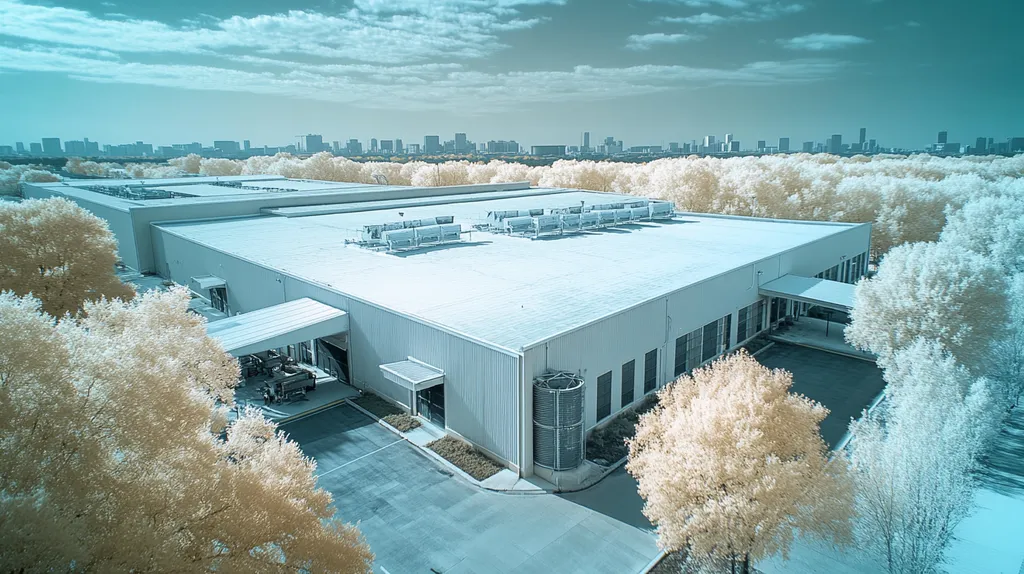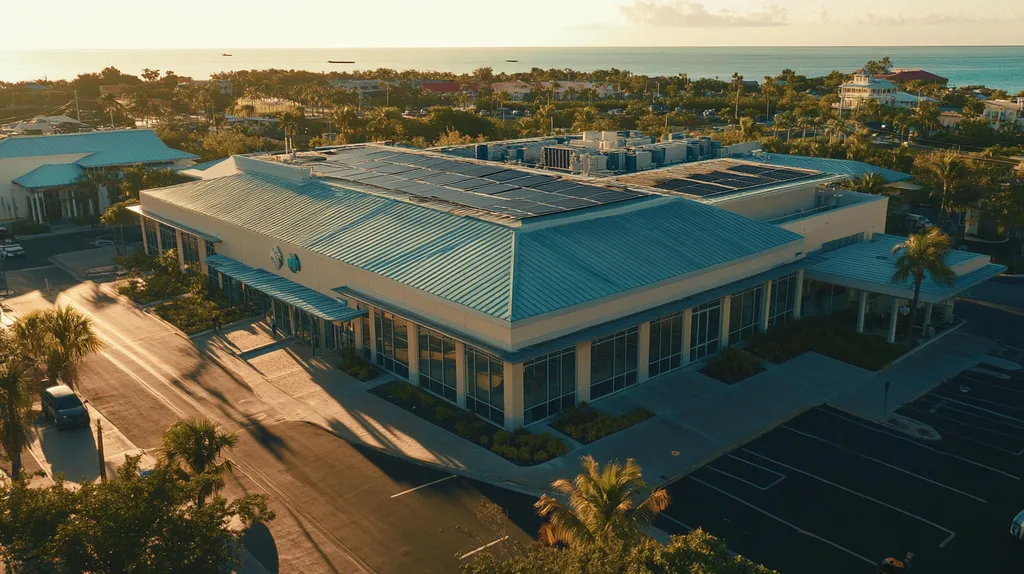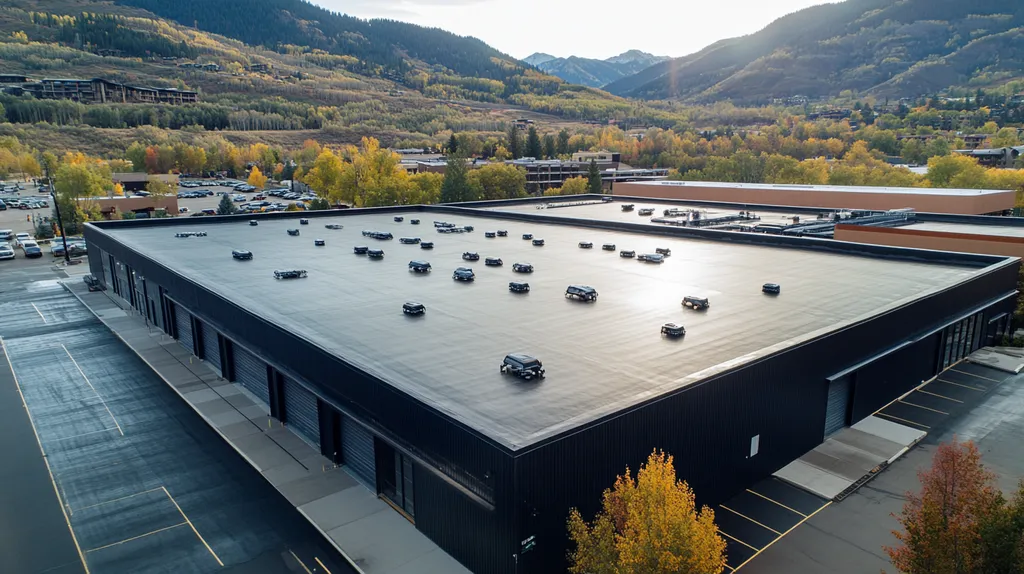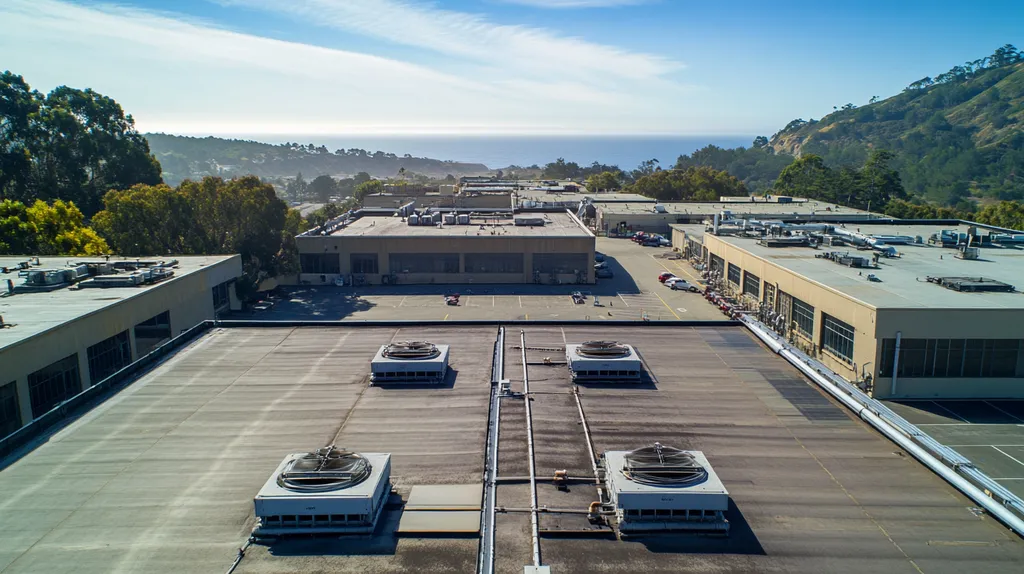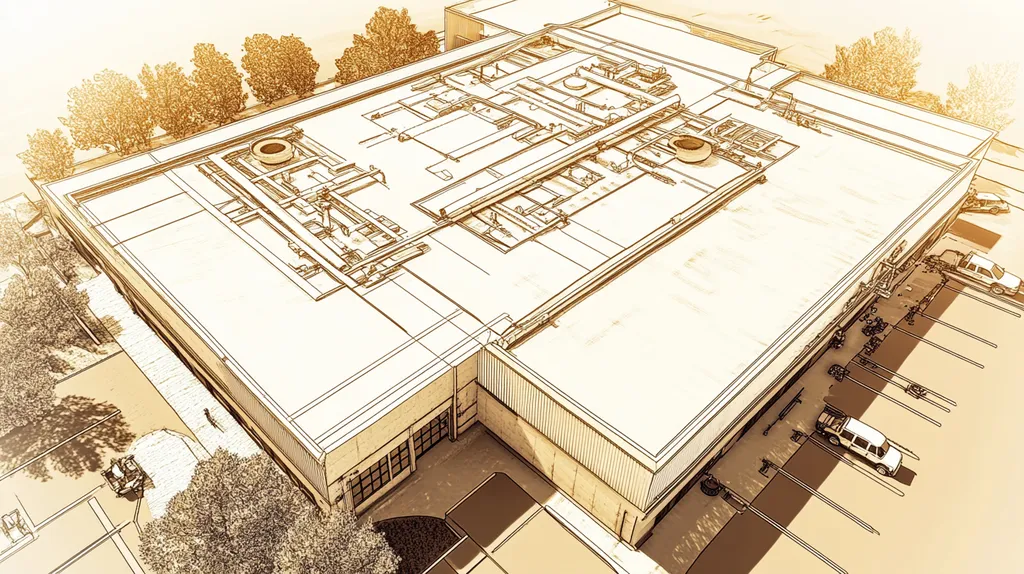Commercial roof leaks cause billions in damage annually, with the average repair costing facility managers between $300-1,000 for minor issues and upwards of $12,000 for major failures. Even small leaks can escalate into catastrophic structural damage within weeks.
For facility managers and property owners, preventing roof leaks requires a systematic approach across multiple operational areas. This includes regular performance monitoring, strategic financial planning, and strict compliance with safety regulations.
This comprehensive guide provides actionable solutions and clear protocols to help facility managers protect their roofing assets and prevent costly water damage. Each section offers specific checklists tailored to key aspects of roof leak prevention.
SECTION 1: PERFORMANCE FACTORS
In the realm of commercial roofing, the financial implications of leaks can escalate rapidly. A single leak can rack up repair costs into the thousands, not to mention the potential liability issues that arise from water damage. For facility managers, grasping the core performance factors that contribute to roof integrity is paramount. This section will explore the importance of roof structure integrity, membrane condition analysis, and drainage system efficiency in preventing leaks.
Roof Structure Integrity
The success of any roofing system is anchored in its structural integrity. A weakened structure can cause uneven weight distribution, which may result in sagging or even roof collapse. Routine inspections of roof frames, trusses, and support beams are essential to ensure they can support the roof’s intended load.
Signs of wear, such as crumbling materials or rot, create weak spots that can lead to leaks. Proactive inspections can detect these issues early, allowing for timely repairs that extend the roof’s lifespan. Investing in structural assessments can save substantial costs over time.
Moreover, external factors like high winds, snow accumulation, and heavy rain can further stress roof structures. Recognizing these challenges and taking steps to reinforce roofing can maintain its integrity. Regular maintenance checks, especially during seasonal transitions, help uncover potential weaknesses before they become costly problems.
Key Action Items
Membrane Condition Analysis
The roofing membrane acts as the primary barrier against moisture. Therefore, its condition must be meticulously monitored. Weather-related factors can degrade the membrane over time, leading to issues like punctures, seam separation, and blistering. Regular visual inspections play a crucial role in spotting such damages.
Understanding the specific type of membrane installed aids in tailoring maintenance strategies. For example, PVC or TPO membranes require different care compared to EPDM systems. Familiarity with each type’s vulnerabilities allows for informed maintenance decisions.
Facility managers should perform detailed evaluations of the membrane’s surface and seams at least twice a year. This diligence enables swift identification of areas needing repair, thereby preventing future leaks. Keeping a documented record of inspections is beneficial for tracking deterioration trends over time.
Key Action Items
Drainage System Efficiency
Efficient drainage is essential for preventing water accumulation, which can lead to leaks and structural issues. A clogged or improperly designed drainage system invites rainwater to pool on the roof, significantly raising the risk of leaks. Therefore, proactive maintenance of gutters, downspouts, and scuppers should be a top priority for facility managers.
Inspecting and clearing debris from the drainage system at least twice annually, particularly during intense weather periods, is critical. Any identified blockages or deficiencies must be addressed quickly to ensure optimal water flow. Taking care of drainage issues now can prevent more costly repairs later.
Understanding the building’s drainage design is also vital. For flat roofs, ensuring proper slope toward drainage points is essential. If the current design fails to facilitate this, modifications may be necessary to improve drainage efficiency.
Key Action Items
SECTION 2: FINANCIAL CONSIDERATIONS
Proactive roof maintenance is a financial necessity rather than a luxury. Ignoring it can lead to disastrous fiscal repercussions. Research shows that repair costs can range from $300 to $1,000, while complete roof replacements can skyrocket to $12,000 or more, influenced by the roof’s size and materials. Facility managers must critically assess repair versus replacement costs, plan budgets for effective maintenance programs, and fully understand their insurance coverage for leaks.
Cost of Repair vs. Replacement
Deciding between repairing a commercial roof or replacing it can have significant financial stakes. For example, a minor leak might cost $500 to fix, but if left unattended, it can lead to water damage or mold—and suddenly, replacement costs could exceed $12,000. This highlights the importance of addressing small issues before they escalate.
Additionally, an aging roof might appear serviceable, yet its consistent wear could result in frequent repairs. This recurring expense can end up costing far more than the initial investment in a new roof. Facility managers need to evaluate each situation individually, considering not only immediate costs but also long-term financial implications.
Regular inspections are a vital tool. They enable facility managers to catch and address minor problems early, ensuring informed decision-making based on accurate information rather than guesses.
Key Action Items
Budgeting for Maintenance Programs
Developing a solid budget for maintenance programs is essential for effectively preventing leaks. Routine maintenance might seem like an extra cost, but it’s a wise investment in the roof’s longevity. By allocating 1-3% of the roofing budget each year for inspections and minor repairs, facility managers can avoid much larger expenses down the road.
For instance, investing $2,000 in regular maintenance may save a facility owner from a $20,000 roof replacement. Studies indicate that proactive care can extend a roof’s lifespan by up to 50%, solidifying the case for prioritizing these expenses.
Moreover, unplanned roof replacements can disrupt daily operations, affecting revenue and productivity. A well-thought-out maintenance budget helps maintain roof integrity, allowing for smooth business continuity. Integrating this budget into the broader facility management strategy is critical.
Key Action Items
Insurance Coverage for Leaks
Understanding insurance coverage for roof leaks is essential for minimizing financial risk. Many facility managers may overlook that their property insurance typically covers roof damage and leaks, provided they have conducted regular maintenance. Keeping up with inspections and maintaining documentation makes it easier to file claims and ensure coverage remains intact.
A frequent mistake is not accurately reviewing the details of insurance policies. Facility managers should work closely with their insurance providers to clarify what types of damage the policy covers, particularly if maintenance lapses might affect coverage. Being informed can ultimately save significant amounts in the event of an incident.
Moreover, proper documentation of maintenance activities can play a crucial role in claims processing. By demonstrating routine care, facility managers can defend against potential accusations of negligence, reinforcing their claims for coverage.
Key Action Items
SECTION 3: COMPLIANCE REQUIREMENTS
For facility managers and property owners, navigating compliance requirements is crucial in the fight against roof leaks. Adhering to building codes, safety regulations, and environmental standards safeguards not just the roof, but the entire facility. Non-compliance risks structural damage, hefty fines, and potentially dangerous situations. Staying updated on these regulations fosters accountability and protects valuable assets.
Building Code Adherence
Complying with building codes is vital for maintaining a roof’s structural integrity. These regulations set the minimum safety standards that must be adhered to during both installation and maintenance. Since building codes differ by location, local regulations must always be consulted.
Failing to meet building code requirements can result in severe penalties such as fines and mandatory repairs. Additionally, improper installation may void warranties and lead to leaks in the future. Regular inspections are essential to confirm ongoing compliance, thereby reducing liability risks.
Moreover, updated building codes often encompass enhancements in energy efficiency and sustainability. Implementing these guidelines not only protects the structure but also improves the overall value of the building.
Key Action Items
Safety Regulations for Inspections
Safety regulations play a critical role in roof inspections and maintenance activities. Regulatory bodies such as OSHA outline specific requirements designed to ensure safe working environments for staff. Following these guidelines protects both employees and the structural integrity of the facility.
Neglecting safety protocols can result in injuries or even fatalities. Such incidents could not only disrupt operations but also expose facility managers to legal consequences. Adhering to safety regulations during inspections fosters a culture of responsibility, improving employee morale and productivity.
In essence, prioritizing safety regulations is fundamental for effective roof inspections, ensuring that worker safety and organizational integrity are upheld.
Key Action Items
Environmental Compliance Standards
Environmental compliance standards are increasingly relevant in the roofing industry. These regulations govern the materials and methods used in construction and maintenance, ensuring protection for ecosystems. Non-compliance can lead to environmental harm and significant penalties.
Many jurisdictions mandate that roofing materials be eco-friendly or recyclable. Following these guidelines not only helps avoid legal issues but also aligns with sustainability goals, enhancing corporate responsibility.
Furthermore, environmentally compliant roofing systems can improve energy efficiency and reduce operational costs. Investing in sustainable materials can yield long-term savings while contributing positively to building performance metrics.
Key Action Items
SECTION 4: RISK MANAGEMENT
Effective risk management is crucial for preventing leaks in commercial roofs. A significant portion of leaks—up to 80%—are unpredictable, leading to costly repairs and operational disruptions. By implementing proactive measures, facility managers can greatly diminish the risk of water damage and uphold the structural integrity of their buildings. This section addresses vital aspects such as leak detection, the risk assessment surrounding roof penetrations, and strategies for mitigating weather-related damage.
Leak Detection and Assessment
Identifying leaks before they become severe is essential for maintaining a commercial roof. Conducting routine inspections, ideally at least twice a year, can help spot early warning signs such as cracks or blisters. Facility managers should leverage advanced technologies like infrared thermography to discover moisture hidden beneath roofing materials.
Keeping a log of inspection results is vital for tracking recurring problems. If certain areas consistently exhibit signs of leaks, those should be prioritized for repairs. Additionally, ensuring compliance with local building codes during inspections can safeguard the roofing system’s integrity.
Engaging professional roofing contractors for thorough assessments can be beneficial. Their expertise and specialized equipment enhance the accuracy of leak detection. Consistent monitoring paired with systematic procedures can lead to significant cost savings over time.
Key Action Items
Risk Assessment of Roof Penetrations
Roof penetrations, such as vents, pipes, and HVAC units, often serve as common entry points for leaks. Conducting regular risk assessments around these areas is crucial for preventing water infiltration. Facility managers should routinely examine flashings and seals to ensure they remain secure and effective.
Installing robust flashing systems can significantly reduce these risks. Opting for metal flashings over less durable materials provides a long-lasting solution. Coordinating maintenance activities with service vendors also helps ensure penetrations are safeguarded against water intrusion.
Maintaining diligent records of all penetrations and their conditions in a maintenance file is essential for tracking changes over time. This approach enables facility managers to make informed repair decisions based on the age and materials of each penetration.
Key Action Items
Mitigating Weather-Related Damage
Extreme weather can severely impact commercial roofs. High winds, heavy snowfall, and intense rainfall intensify existing vulnerabilities. To mitigate weather-related damage, facility managers must develop effective contingency plans.
Routine evaluations before and after severe weather events are essential to assess potential damage. This includes checking for missing shingles, loose materials, or any signs of ponding water that indicate drainage issues. Prompt action after inclement weather is vital to ensure manageable repairs.
Implementing preventive measures, such as improving drainage systems and strengthening the roof structure, offers additional protection. Ensuring that gutters and downspouts are clear and functioning effectively can significantly reduce water accumulation on the roof.
Key Action Items
SECTION 5: OPERATIONAL PROCEDURES
To protect valuable assets and ensure maximum return on roofing investments, maintaining commercial roofs is essential. A single leak can spiral into major damage, resulting in costly repairs and reduced productivity. Research indicates that regular maintenance can extend a roof’s life by 20-30%. This section outlines vital operational procedures, including scheduled inspections, preventive maintenance tasks, and efficient emergency response strategies.
Regular Inspection Schedules
Establishing a consistent inspection schedule is crucial in identifying potential issues early. Ideally, commercial roofs should undergo inspection at least twice a year, during spring and fall. Inspections should also follow significant weather events, as storms can reveal hidden damage.
During these inspections, facility managers should look for common concerns such as missing shingles, clogged drains, and compromised flashing. Utilizing a checklist ensures thorough coverage, helping managers document findings that track wear over time.
Incorporating technology like drones and infrared cameras can significantly enhance inspection precision. These tools help identify issues that may not be visible, allowing for a proactive approach to roof maintenance. Engaging professional roofing contractors can provide expert insights that reinforce asset protection.
Key Action Items
Preventive Maintenance Tasks
A robust preventive maintenance program helps avert common issues that can lead to leaks. Key tasks include regular cleaning of gutters and downspouts to avoid water buildup. Ensuring debris-free roofs prevents moisture from accumulating against surfaces, safeguarding materials.
Facility managers should frequently inspect sealants and flashing for wear, as these components are critical barriers against leaks. Promptly replacing deteriorated materials can mitigate larger repair costs down the line.
Maintaining rooftop equipment such as HVAC units is equally important. Regular inspections of these installations can help identify potential leaks due to poor sealing. Training maintenance staff to recognize early warning signs enhances overall upkeep and durability.
Key Action Items
Emergency Leak Response Strategies
Having a clear emergency response strategy is vital for addressing leaks swiftly and effectively. Quick action minimizes water damage and helps protect valuable equipment. Facility managers should establish a seamless communication protocol for reporting any leaks as they arise.
Assemble an emergency response team trained to assess leakage situations and implement temporary repairs. Equipping this team with emergency repair kits allows for immediate action to limit damage.
Maintaining a list of reliable roofing contractors for emergencies ensures that professional help is readily available when needed. Following any emergency, a thorough investigation should determine the leak’s source, allowing for adjustments to preventive measures to avoid recurrences.
Key Action Items
SECTION 5: OPERATIONAL PROCEDURES
Maintaining commercial roofs is vital for protecting property and optimizing investments. A single leak can escalate into considerable damage, resulting in thousands of dollars in repairs and decreased productivity. Research indicates that proactive maintenance can extend a roof’s lifespan by 20-30%. This section outlines essential operational procedures, highlighting the importance of regular inspection schedules, preventive maintenance tasks, and effective emergency response strategies.
Regular Inspection Schedules
Establishing a routine inspection schedule is critical for identifying potential leaks before they worsen. Commercial roofs should be inspected at least twice a year, ideally in the spring and fall. Inspections should also occur after severe weather events, as storms can cause unseen damage.
During these inspections, facility managers need to check for issues like missing shingles, clogged drains, and compromised flashing. Utilizing a checklist can help ensure no critical area is overlooked, while documenting findings allows managers to monitor deterioration over time.
Moreover, leveraging technology such as drones and infrared cameras can enhance inspection accuracy. These tools detect problems that aren’t visible to the naked eye. Engaging professional roofing contractors for inspections brings added expertise, helping identify potential hazards and ensuring roofs remain watertight.
Key Action Items
Preventive Maintenance Tasks
A robust preventive maintenance program is essential for preventing leaks. This includes tasks like regularly cleaning gutters and downspouts to avoid water buildup. Removing debris is crucial, as leaves and branches can trap moisture against the roof’s surface.
Another essential task is checking sealants and flashing for wear. Over time, these components can degrade due to weather exposure, making roofs prone to leaks. Timely replacement of worn materials can prevent expensive repairs in the future.
Additionally, ensuring rooftop equipment such as HVAC units is well-maintained is crucial. Regular inspections of these elements can identify potential leaks due to inadequate sealing. Moreover, educating maintenance staff on early signs of wear enhances overall roof care effectiveness.
Key Action Items
Emergency Leak Response Strategies
Having a clear emergency response strategy is crucial for effectively managing leaks. Quick action can minimize water damage and protect valuable assets. Facility managers should establish a communication protocol to report leaks promptly.
Setting up a dedicated emergency response team ensures a rapid response when leaks are detected. This team, trained to assess damage and implement temporary repairs, should be equipped with emergency repair kits for immediate action.
Moreover, maintaining a list of trusted roofing contractors for emergencies is beneficial. Quick access to professional help can prevent minor issues from escalating into significant repairs. After any emergency, conducting a thorough investigation to identify the leak’s source allows for improved preventive measures to reduce future occurrences.
Key Action Items
The Bottom Line
Commercial roof leaks cost U.S. businesses over $3.7 billion annually in repairs, replacement, and lost productivity. Without systematic prevention, even minor leaks can escalate into catastrophic structural failures within weeks.
Effective leak prevention requires an integrated approach across performance monitoring, financial planning, and regulatory compliance. The cornerstone of this strategy is maintaining strict inspection schedules and addressing issues promptly.
Facility managers who implement comprehensive maintenance programs can extend roof lifespans by up to 50% while reducing repair costs by 40% compared to reactive maintenance approaches.
By following the actionable protocols outlined in this guide, property owners and facility managers can protect their roofing assets, prevent costly water damage, and ensure regulatory compliance for years to come.
FREQUENTLY ASKED QUESTIONS
Q. What performance factors affect my commercial roof?
A. Factors like roof structure integrity, membrane condition, and drainage efficiency are critical. Regular inspections can help identify issues that might compromise your roofing system’s effectiveness.
Q. How do I budget for commercial roof maintenance?
A. Allocate 1-3% of your roofing budget annually for maintenance. Regular reviews and planned expenses can prevent larger costs associated with unexpected repairs or replacements.
Q. What compliance requirements should I follow for my industrial roof?
A. Familiarize yourself with building codes and safety regulations. Adhering to these rules will help maintain structural integrity and avoid fines or legal issues.
Q. How can I manage risks related to my roof?
A. Implement regular leak detection and assess roof penetrations. Strengthening your roof structure and improving drainage can significantly mitigate potential weather-related damage.
Q. What operational procedures should I follow for roof maintenance?
A. Regular inspections, cleaning, and a robust emergency response strategy are critical. Documenting maintenance activities helps track the condition of your roof effectively.
Q. What are the advantages of preventive maintenance for commercial roofs?
A. Preventive maintenance can extend a roof’s lifespan by 20-30%. It helps prevent leaks, reduces repair costs, and ensures your facilities remain functional and safe.
Q. How do weather conditions affect my industrial roof’s durability?
A. Extreme weather can deteriorate roofing materials, leading to leaks and structural damage. Regular assessments, especially after severe weather, are essential to maintain roof integrity.

